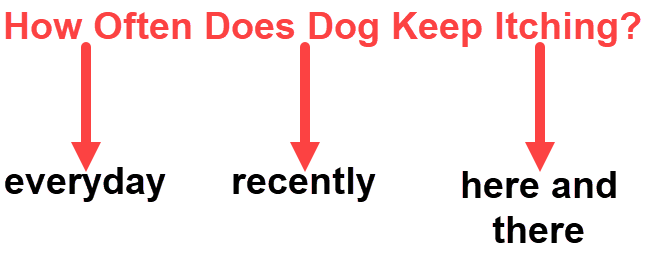What To Do When Dog Is Itching And Scratching A Lot
Itching and scratching are common behaviors among dogs, especially in warm weather. But if this behavior is extreme, there is a problem. According to vets, if your dog keeps scratching a particular area, losing hair, and creating sores, there is an underlying condition.
It can be frustrating as a pet owner to watch your dog being uncomfortable.
The good news is that dog itching often isn’t life-threatening and can be treated in most cases. However, before starting the treatment, you must know what is causing the itching and irritation.
Several things can cause dog scratching behavior. It could indicate something on the dog’s skin or internal issues inside its body. Whatever the reason is, itching is always uncomfortable and can give your pet sleepless nights and troubling days.
Today, we talk about the causes of itching and how you can address this problem. Keep reading to learn more.

What Causes Dog Itching?
Several reasons result in dog itching skin. Let us look at the most common ones…
#1. Parasites
Some parasites see your dog as a meal. Hence, they’re every ready to make feed on him. If this happens, your dog will start itching and get uncomfortable. These parasites include:
- Mites
Although tiny creatures, they can make the life of your pet a living hell. Mites measure less than millimeters, and they aren’t insects like most people think. Instead, they are related to spiders and have eight legs.
Mites can cause dry skin and hair loss which results in itching. They can also bring a mange disease that causes hair loss in patchy areas. Mange is of two types. And it is caused by two types of mites; sarcoptic and demodectic.
Sarcoptic mange is what we commonly know as scabies, and it can cause severe itchiness. In search of relief, the dog will scratch himself. However, intense scratching can lead to coat damage, scabs, and skin inflammation. This condition can also affect human beings.
On the other hand, demodectic mange results in hair loss, lesions, and red patches with scales and crusts.
If your dog is mostly scratching his ears or face, he might have mites in these places. And usually, the best intervention is to take him to a veterinarian.
- Ticks
These insects attack your dog to feed on his blood. There are various types of ticks, and you can see most of them as they are large. When they attach to the dog’s skin, they start sucking the blood until full. Then they’ll leave the dog.
You may see the attachments that ticks made on your dog’s skin if you look closely. These areas usually have a red itchy mark. Other than itching, ticks can carry several diseases like Lyme disease. For this reason, they should be removed and treated by a vet as soon as possible.
- Fleas
Pet owners fear fleas for a good reason. These tiny pests measure around eight inches long. They suck blood from your dog and can make his life miserable. Fleas also attack human beings and can infest a home. The most disturbing thing about these pests is that they can bite your dog as many as 400 times a day.
Is Your Dog Itching A Lot? – Get Answers FAST!
• Its Important To Know How Often Your Dog May Be Itching And Scratching To Determine How Serious It Can Be… Choose Below How Often Your Little One May Be Itching…
Have Concerns About Your Pet… Not Sure If Something Serious Could Be Going On With Your Dog… ASK All Your questions Below To Online Specialized Dog Vets Who Are Available 24/7 To Find Out Why Your Dog Is Scratching…
The bites are painful, and they give out an irritating substance from their saliva. As such, they’ll make a dog scratch his skin violently. Worse is that some dogs have a flea allergy. Thus, if these pets attack them, they quickly develop bare spots.
If you suspect fleas have attacked your dog, it’s best to take him to a vet for treatment.
#2. Seasonal Allergies
We love and appreciate warm months. However, they could be the worst time for dogs. Note that fleas and other pests increase during these months when most plants shed pollen.
Pollen doesn’t seem to affect most dogs. However, those with a genetic predisposition to allergies can get affected. Allergic reactions to pollen, mold, or dust often result in itchiness, making your dog scratch and bite himself intensely around their ears and paws.
Sadly, you cannot cure dog allergies caused by the changing seasons. But, you can use some treatments like antihistamines to minimize or stop the symptoms.
#3. Food Allergies
Other than seasonal allergies, food allergies can also cause itching in dogs. You’ll see them scratching, rubbing, or even chewing. But, these reactions are dangerous as they may lead to secondary infections from bacteria or fungus. Food allergies can also cause hair loss, diarrhea, and vomiting.
A veterinarian can suggest an isolation diet for dogs with allergies to determine the foods bringing the symptoms. However, this is a temporary diet that may take several weeks and requires that you pay close attention. Then, they will suggest a long-term diet that excludes allergic ingredients.
#4. Skin Infections
Several skin conditions and infections can cause your dog to itch and scratch. These include;
- Atopic Dermatitis
Atopic Dermatitis is a common skin condition in dogs caused by a dog’s particular genetics and environment. If your dog has this condition, flares can be triggered by mold, pollen, or dust. However, the leading cause is an improper skin reaction, not the allergens themselves.
Dogs with this condition will chew and lick paws and scratch their ears, eyelids, and faces. The proper treatment will depend on your dog. But it mainly involves avoiding allergens and includes medications for treating this condition.
- Dry Skin
Your dog’s skin tends to become itchy and dry in winter. And if your pup swims during the summer, the chemicals in a swimming pool can also irritate his skin. Again, some dog skincare products can cause dryness, although some are specifically designed for dry skin.
- Yeast Infection
Yeast commonly infects the skin and ears. In low numbers, they are unproblematic. However, if they overgrow, they can cause an infection that makes your dog itchy. It also causes red or flaky skin and a foul odor.
Warmth and humidity increase yeast infections, especially under your puppy’s folds and ears.
How to Help My Dog from Itching?
The best way to help your dog from itching is to identify the cause. Without knowing the reasons, all the treatments you take will be in vain. Here are six home remedies you can use to give your pet some relief from itching.
Chamomile and Herbal Tea Soaks
These herbs contain soothing and cooling properties. As such, they offer relief to irritated skin. If your dog has intense itchy skin patches, you can soak him in these herbs.
First, fill a tub or sink with warm water. Then, add the herbal tea bags and allow some minutes to steep. After, remove the bags and let your pet soak for 5 minutes or more.
Soaking is best for dogs that are itching all over. But if your puppy only has small itchy patches, steep a bag or two in 2 cups of hot water. Let it cool down and pour the water into your dog’s skin. Don’t rinse. Instead, allow it to drip.
Colloidal Oatmeal Baths
These baths help lessen inflammation and eliminate allergens in your pet’s fur. You can buy pre-made colloidal oatmeal or make it yourself by grinding plain oatmeal and turning it into a powder. Then bathe your dog with this powder. It helps relieve redness, swelling, and itchiness caused by inflammation. Plus, it also offers cooling benefits.
Coconut Oil
Coconut oil is suitable for itching caused by allergies, atopic dermatitis, bug bites, and skin infections. This oil contains antibacterial and antimicrobial properties that provide soothing to an itchy dog.
Apple Cider Vinegar (ACV) and Water Spray
ACV is a great relief for dry, itchy skin. It contains antiseptic and antifungal properties, which help relieve irritation from allergens like poison ivy. However, it should be used on raw or opened skin. Fill ACV with an equal water amount. Then use it only on targeted areas. You can soak your dog’s paws if he’s walked on poison ivy or oak in this solution for about 5 minutes.
Aloe Vera
Aloe vera has mostly been used to offer relief to sunburns. It contains powerful healing properties. As such, it can reduce redness and block the uncomfortable heat from your skin. Your dog can also benefit from this great ingredient.
Apply it to the affected areas of your dog’s skin. You can get it from drugstores, or if you have an aloe vera plant at home, harvest from it.
Baking Soda
A paste of baking soda with water can help relieve rashes on the skin and itching. Plus, moisture can reduce redness and inflammation. Combine baking soda and water in equal ratios. Then apply the paste to the affected areas. Wait approximately 20 minutes before rinsing it off. You can also add coconut oil to this paste. And for dogs experiencing itchiness, you can add baking soda to their bath.
Conclusion
Scratching a little from time to time isn’t a cause for alarm. However, if it is intense, you may want to seek intervention. A vet can help you figure out what’s causing the itching and the best remedies to help your dog get better.

